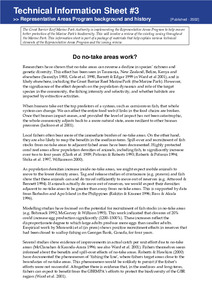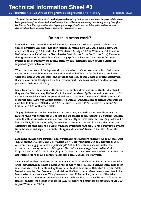Please use this identifier to cite or link to this item:
https://hdl.handle.net/11017/771Technical information sheet 3: Do no-take areas work?

View this entry
Full metadata record
| DC Field | Value | Language |
|---|---|---|
| dc.date.accessioned | 2012-10-26T01:38:00Z | null |
| dc.date.available | 2012-10-26T01:38:00Z | null |
| dc.date.copyright | 2002 | en |
| dc.date.issued | 2002 | en-US |
| dc.identifier.uri | http://hdl.handle.net/11017/771 | null |
| dc.description.abstract | Researchers have shown that no-take areas can reverse a decline in species’ richness and genetic diversity. This effect has been seen in Tasmania, New Zealand, Belize, Kenya and elsewhere (Samoilys 1988, Cole et al. 1990, Barrett & Edgar 1999 in Ward et al 2001), and is likely elsewhere, including the Great Barrier Reef Marine Park (the Marine Park). However, the significance of the effect depends on the population dynamics and role of the target species in the community, the fishing intensity and selectivity, and whether habitats are impacted by extractive activities. | en |
| dc.publisher | Great Barrier Reef Marine Park Authority | en |
| dc.relation.ispartofseries | Technical Information Sheet | en |
| dc.title | Technical information sheet 3: Do no-take areas work? | en |
| dc.type | Brochure | * |
| dc.subject.asfa | Biodiversity | en |
| dc.subject.asfa | Protected areas | en |
| dc.format.pages | 3 | en |
| dc.contributor.corpauthor | Great Barrier Reef Marine Park Authority | en |
| dc.subject.apais | Environmental management | en |
| dc.publisher.place | Townsville | en |
| dc.subject.collection | Managing Multiple Use | en |
| dc.relation.connectiontogbrmpa | GBRMPA published this item | en |
| dc.subject.category | Information Publication Scheme | en |
| dc.subject.category | Zones, plans and maps | en |
| dc.subject.location | Reef-wide | en |
| Appears in Collections: | Management | |
Files in This Item:
| File | Description | Size | Format | |
|---|---|---|---|---|
| Technical-information-sheet-3-No-take-areas-2002.pdf | 117.58 kB | Adobe PDF |  View/Open |
Items in the ELibrary are protected by copyright, with all rights reserved, unless otherwise indicated.
